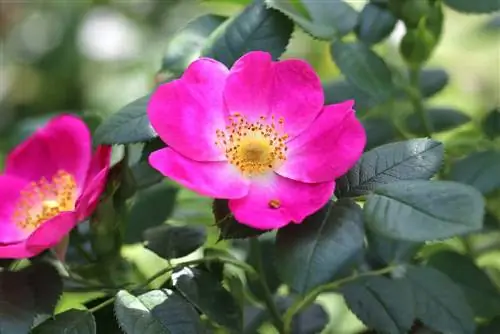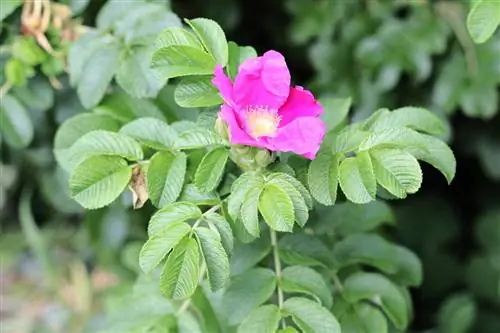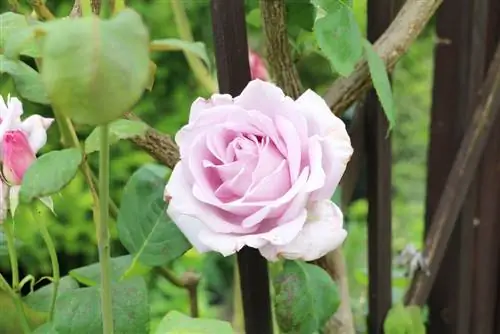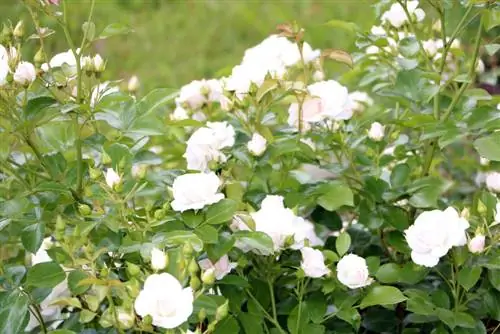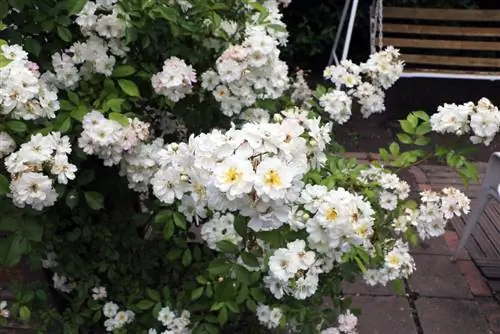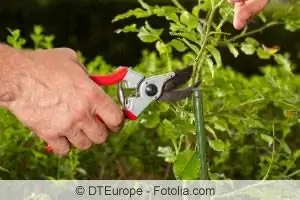- Author admin [email protected].
- Public 2023-12-17 03:39.
- Last modified 2025-01-24 12:45.
In addition to the dog rose, there are other wild rose species such as the apple rose or the potato rose. They have the advantage that nature has given them some properties that make them significantly less sensitive to extreme weather, for example. Although they do well on their own, wild versions of the rose also benefit from good care. This promotes strong growth and produces many flowers.
Fertilize
Barren soils are not a problem for the wild rose, but it reacts accordingly with reduced flowering. This is purely self-protection, because on the one hand it lacks the nutrients to produce many flowers.to keep them alive and on the other hand she sees little chance for the fruits in the surrounding area to develop well.
However, too many nutrients also harm the roses, as this only promotes the formation of new shoots, but the flowers usually do not bloom either. The challenge for gardeners is therefore to find an ideal balance in the nutrient balance. Therefore, the wild form of roses should only be fertilized a maximum of once a year.
The ideal time is in the spring when budding occurs. Mature compost is used for fertilization, which is worked into the soil on the one hand and can also be piled up on the other. Like all roses, wild forms also like piling up and often react with new shoots from the ground.
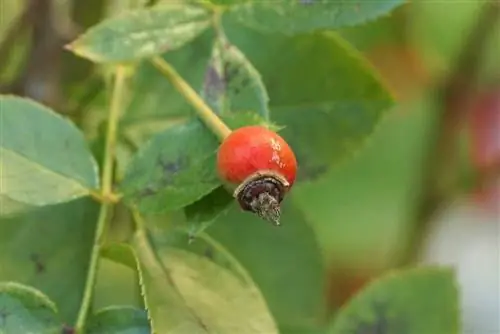
Tip:
In autumn you can also mulch with some leaves, which is good protection for the winter and also provides some nutrients and he althy soil life in the area around the rootstock.
Pouring
The wild rose and also cultivated forms of it such as “Rosy boom” can tolerate prolonged drought. But even very wet soils usually don't bother them much, provided they aren't permanently submerged in water. The rose bushes do not necessarily need to be watered in summer. However, in the flower bud and flowering phases, the wild forms are just as sensitive as cultivated varieties. Therefore, in the event of prolonged drought in spring or early summer, water should be regularly watered until flowering ends. The following points should be taken into account when watering:
- use lime-free water (rainwater)
- Avoid waterlogging
- Do not water the leaves
Waterlogging is a common problem, especially in very heavy soils. This can be counteracted by loosening the soil around the rose several times a year. If necessary, some sand can also be incorporated. When loosening the soil, however, care must be taken not to work too deeply into the soil so that the roots are not damaged.
Propagation
Propagate roses is always difficult with cultivated forms. It is completely different with the wild original form of roses. If there is already a popular variety in the garden or you have discovered a beautiful shrub in the wild, there are several ways you can propagate the plants.
The more complex variant is propagation via seeds. To do this, follow these steps:
- harvest ripe rose hips.
- Remove cores
- Put the seeds in the ground in autumn (do not use a seed tray)
- preserve from drying out until sprouting
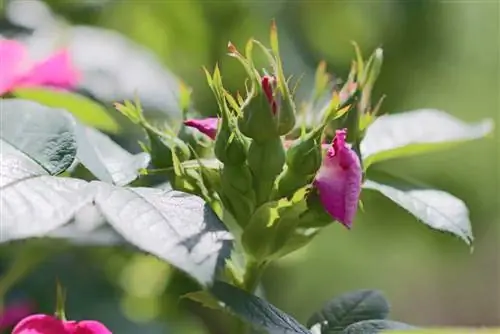
In order for wild forms of roses to germinate, they need a pulse of cold and must lie in the ground over the winter. During this time it is particularly important that the kernels do not dry out.
Tip:
If you forget to sow the seeds in the fall, you can try putting them in the refrigerator for one to two weeks and then sowing them in the spring. This cold impulse is often enough to encourage the seeds to germinate, although direct sowing in autumn is usually more successful.
The simpler and quicker method is to propagate via cuttings in autumn. To do this, two-year-old shoots are cut off at an angle with a sharp knife. The shoots should have at least eight to ten eyes. Everything above it is also removed with an oblique cut. The cuttings are then buried at least four to five eyes deep in the ground. By next spring, new shoots should have formed on the remaining eyes on the surface.
Diseases and pests
The good news is that there are no diseases that are feared in the cultivated forms that could affect the wild forms. Even cultivated wild forms like Rosy boom are not susceptible to disease. However, there are some pests that do not cause the plant to die, but can harm its development and the flowers. These include:
- Rose gall wasp
- Garden leaf beetle
- Rose beetles (various species)
Especially little to hardly can be done against the rose beetles. In some cases, some species of rose beetles are even protected and therefore may not be killed. If there is an increased occurrence of rose beetles, the beetles can be collected and released on other flowering plants such as elderberries. There are suitable attractant traps commercially available for the garden chaff beetle. It also helps not to mow the lawn too short during the flight season in May and June. Open spots in the grass are a welcome invitation for him to lay his eggs there. The larvae then damage the lawn, while the adult beetles attack the plants in the garden, such as wild roses.
If the rose gall wasp lays its eggs in the wild rose, this leads to unsightly growth and the so-called rose galls or gall apples are formed. Although the rose gall apples have an interesting appearance, they can weaken the roses. A few gall apples do not harm the rose; if they occur more often, the affected branches should be cut off. The gall apples can simply be disposed of in the compost.
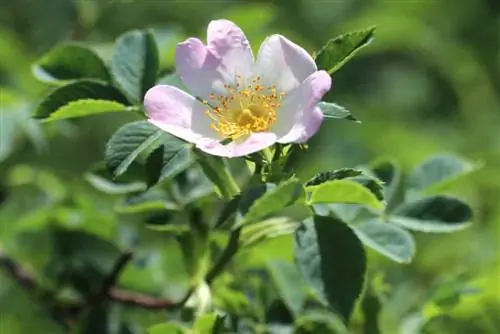
As a preventive measure, beneficial insects can also be promoted in the garden, which make life difficult for harmful insects. These primarily include parasitic wasps, various robber flies and birds. The parasitic wasps are particularly helpful in combating the larval stage, as the parasitic wasp lays its eggs in the larvae of other insects.
Cutting
The pruning of wild forms of the rose differs significantly from cultivated forms. In principle, the wild form would not require any pruning, but it is usually necessary to slow down the lush growth somewhat. There are three variants when cutting:
- Plant cutting
- annual cut
- Radical cut
Plant cutting
Planting pruning is only done when planting. Strong shoots are shortened to four to five eyes. Weaker shoots on a maximum of two eyes. Very weak or stunted shoots can be removed entirely. In the end you should have a compact hive with enough space for all shoots. If the cane is very dense, weak shoots can also be cut off close to the ground.
Annual cut
Annual cut can be done either in spring or autumn. The aim of this cut of the dog rose is, on the one hand, to shape it and, on the other hand, to remove the remains of the fruit stalks. Pruning can be done in autumn when the fruit ripens. However, many people leave the rose hips on until next year as decorative autumn decorations and for birds. In this case, the remaining fruit heads are cut back in the frost-free spring at the latest.
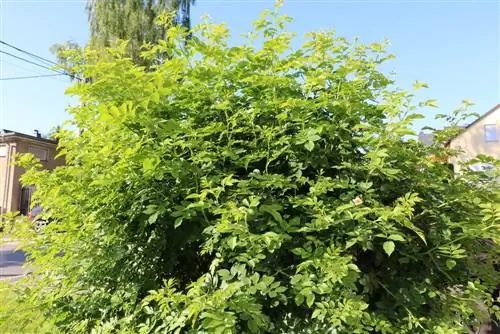
Regardless of whether the fruits stay on or not, topiary should definitely be done in autumn. For example, branches and twigs that are too close are removed. Shoots older than three years are also removed in autumn to stimulate the formation of young and strong shoots.
Radical cut
Rosy boom and other wild forms of roses also require little effort in terms of care. It is entirely possible to let the wild form grow for several years without cutting it. The problem, however, is that after a while the lower area tends to become bald and is no longer very attractive to look at. Then at the latest it's time for a radical cut.
This is done in early autumn so that the perennial has enough time to close the wounds. If a radical cut is carried out in spring, it can cause the roses to bleed and die completely. In autumn, however, gardeners have the chance not only to get the perennials through the winter well, but also to encourage the sprouting of sleeping eyes in the spring.
A radical cut usually goes deep into the old wood. Old branches are shortened to about hip height. The interface should not be set too low, otherwise the chance of awakening sleeping eyes becomes ever smaller. If a radical cut even promotes new shoots from the ground, very old shoots that have only been shortened to waist height can be completely removed next year.
Tip:
Shoots resulting from pruning can be used again as cuttings.

